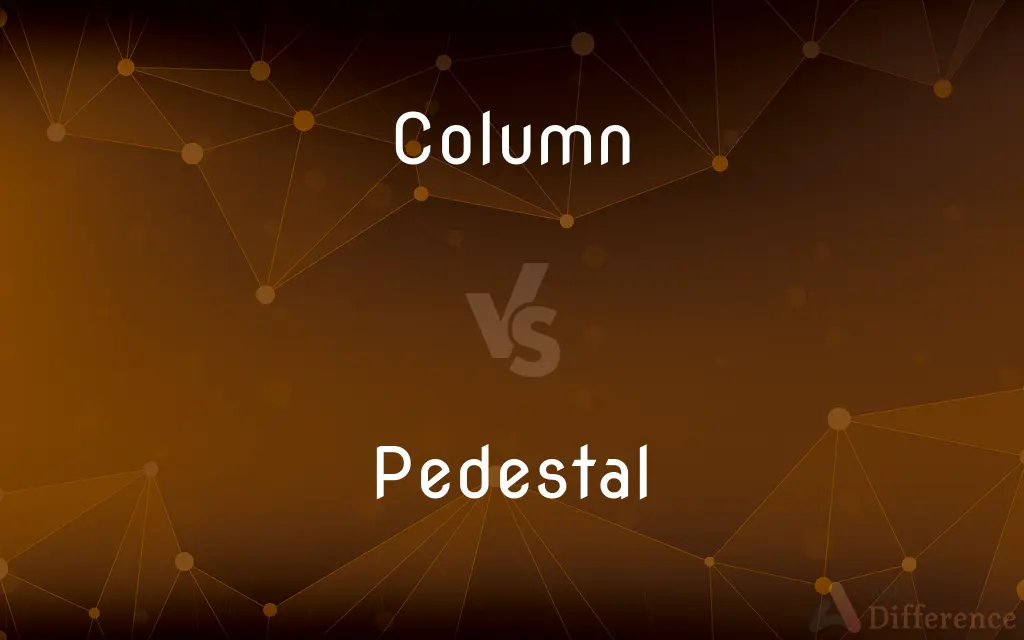Column vs. Pedestal — What's the Difference?
By Tayyaba Rehman & Maham Liaqat — Updated on March 8, 2024
Columns are architectural structures designed to support weight, often decorative, while pedestals are bases supporting statues, vases, or other artifacts.

Difference Between Column and Pedestal
Table of Contents
ADVERTISEMENT
Key Differences
Columns are integral to architecture, primarily used for structural support and ornamentation. They can be found in various styles, such as Doric, Ionic, and Corinthian, each with unique characteristics. Columns not only bear the weight of the structures above but also add aesthetic value to buildings. Whereas pedestals serve as the foundation or support for statues, vases, or other decorative objects. Designed to elevate and highlight the object it supports, a pedestal can range from simple to elaborate designs, depending on its context and the importance of the object it displays.
Columns are often made from materials like stone, marble, wood, or concrete, chosen for their strength and durability to support significant weight. The design of a column includes parts such as the base, shaft, and capital, each contributing to its overall appearance and function. Pedestals, on the other hand, might be constructed from similar materials but are typically smaller and less structurally complex. Their primary purpose is not to support architectural weight but to elevate and present an object, making material choice more flexible based on aesthetic considerations rather than structural necessity.
From a historical perspective, columns have played a vital role in the architecture of ancient civilizations, including Greek and Roman, where they were essential elements in temples and public buildings, symbolizing strength and beauty. Pedestals, while also used in ancient times, have been more associated with the display of art and artifacts, highlighting their significance and enhancing their visibility in a space.
Columns are necessary for the structural integrity of buildings and often form part of the architectural design, influencing the overall style of a construction. They may also create a rhythmic or harmonious effect when used in series. Pedestals, however, are primarily functional in an aesthetic sense, designed to complement and elevate the art or object they support, often playing a crucial role in how these items are perceived by viewers.
In interior and exterior design, columns can define spaces, create visual interest, and add a sense of grandeur or historical reference to a building. Pedestals add value by drawing attention to specific objects, creating focal points, and contributing to the narrative or thematic elements of a space. They offer a platform that distinguishes and valorizes the item on display, whether in a gallery, public space, or private setting.
ADVERTISEMENT
Comparison Chart
Primary Function
Structural support and ornamentation.
Supporting and elevating objects.
Composition
Made of stone, marble, wood, or concrete.
Often made from similar materials but less structurally complex.
Historical Use
Essential in ancient Greek and Roman architecture.
Used to display art and artifacts, enhancing visibility.
Design Elements
Includes base, shaft, and capital.
Design varies from simple to elaborate, focusing on aesthetic.
Role in Design
Defines spaces and adds grandeur.
Creates focal points and highlights specific objects.
Compare with Definitions
Column
A key component in ancient Greek and Roman architecture.
Greek temples are renowned for their use of Doric columns.
Pedestal
A base supporting statues, vases, or other artifacts.
The bronze statue stood on a granite pedestal in the center of the square.
Column
Features a base, shaft, and capital; varies by architectural order.
Corinthian columns are distinguished by their ornate capitals.
Pedestal
Elevates and highlights the object it supports.
The pedestal elevated the vase, making it the focal point of the room.
Column
A structural element that supports the weight above it.
The ancient temple was supported by towering marble columns.
Pedestal
Can be made from a variety of materials, chosen for aesthetic qualities.
A wooden pedestal was chosen to complement the sculpture.
Column
Provides both structural support and decorative appeal.
The columns added both elegance and stability to the building.
Pedestal
Ranges from simple to elaborate, depending on its purpose.
The pedestal's intricate design drew attention to the displayed artifact.
Column
Often constructed from durable materials like stone or marble.
Stone columns are a hallmark of classical architecture.
Pedestal
Often associated with the display of art and artifacts.
Ancient pedestals were used to elevate sculptures in temples.
Column
An article giving opinions or perspectives
Pedestal
A pedestal (from French piédestal, Italian piedistallo 'foot of a stall') or plinth is the support of a statue or a vase, and of a column in architecture. Smaller pedestals, especially if round in shape, may be called socles.
Column
A column or pillar in architecture and structural engineering is a structural element that transmits, through compression, the weight of the structure above to other structural elements below. In other words, a column is a compression member.
Pedestal
An architectural support or base, as for a column or statue.
Column
A vertical structure usually consisting of a base, a cylindrical shaft, and a capital, used as a support or standing alone as a monument.
Pedestal
A support or foundation.
Column
Any slender vertical support, as of steel or reinforced concrete.
Pedestal
A position of high regard or adoration.
Column
Something resembling an architectural column in form or function
A column of mercury in a thermometer.
Pedestal
To place on or provide with a pedestal.
Column
One of two or more vertical sections of text lying side by side in a document and separated by a rule or a blank space.
Pedestal
(architecture) The base or foot of a column, statue, vase, lamp.
Column
An arrangement of numbers in a single vertical line.
Pedestal
(figuratively) A place of reverence or honor.
He has put his mother on a pedestal. You can't say a word against her.
Column
A feature article that appears regularly in a publication, such as a newspaper.
Pedestal
(rail transport) A casting secured to the frame of a truck of a railcar and forming a jaw for holding a journal box.
Column
A formation, as of troops or vehicles, in which all elements follow one behind the other.
Pedestal
(machining) A pillow block; a low housing.
Column
(Botany)A columnlike structure, especially one formed by the union of a stamen and the style in an orchid flower, or one formed by the united staminal filaments in flowers such as those of the hibiscus or mallow.
Pedestal
(bridge building) An iron socket, or support, for the foot of a brace at the end of a truss where it rests on a pier.
Column
(Anatomy)Any of various tubular or pillarlike supporting structures in the body, each generally having a single tissue origin and function
The vertebral column.
Pedestal
(steam heating) a pedestal coil, group of connected straight pipes arranged side by side and one above another, used in a radiator.
Column
(architecture) A solid upright structure designed usually to support a larger structure above it, such as a roof or horizontal beam, but sometimes for decoration.
Pedestal
(telecommunications) A ground-level housing for a passive connection point for underground cables.
Column
A vertical line of entries in a table, usually read from top to bottom.
Pedestal
(electronics) The measured value when no input signal is given.
Column
A body of troops or army vehicles, usually strung out along a road.
Pedestal
(aviation) The central part of the cockpit, between the pilots, where various controls are located.
Column
A body of text meant to be read line by line, especially in printed material that has multiple adjacent such on a single page.
It was too hard to read the text across the whole page, so I split it into two columns.
Pedestal
The tough protuberant pad covering a dromedary's sternum, which, when the camel lies down, causes the abdomen to be slightly above the hot ground.
Column
A unit of width, especially of advertisements, in a periodical, equivalent to the width of a usual column of text.
Each column inch costs $300 a week; this ad is four columns by three inches, so will run $3600 a week.
Pedestal
To set or support on (or as if on) a pedestal.
Column
(by extension) A recurring feature in a periodical, especially an opinion piece, especially by a single author or small rotating group of authors, or on a single theme.
His initial foray into print media was as the author of a weekly column in his elementary-school newspaper.
Pedestal
The base or foot of a column, statue, vase, lamp, or the like; the part on which an upright work stands. It consists of three parts, the base, the die or dado, and the cornice or surbase molding. See Illust. of Column.
Build him a pedestal, and say, "Stand there!"
Column
Something having similar vertical form or structure to the things mentioned above, such as a spinal column.
Pedestal
A short free-standing column or column-like object designed to support a work of art or other object; a column serving the same function as the base of a statue. It may be made of wood, marble, or other suitable material.
Column
(botany) The gynostemium
Pedestal
A part of a desk which contains a frame and drawers, stands on the floor, and provides support for the desk surface. There may be zero, one, or two such pedestals in a desk.
Column
(chemistry) An object used to separate the different components of a liquid or to purify chemical compounds.
Pedestal
A casting secured to the frame of a truck and forming a jaw for holding a journal box.
Column
A kind of pillar; a cylindrical or polygonal support for a roof, ceiling, statue, etc., somewhat ornamented, and usually composed of base, shaft, and capital. See Order.
Pedestal
A support or foundation;
The base of the lamp
Column
Anything resembling, in form or position, a column in architecture; an upright body or mass; a shaft or obelisk; as, a column of air, of water, of mercury, etc.; the Column Vendôme; the spinal column.
Pedestal
A position of great esteem (and supposed superiority);
They put him on a pedestal
Column
A body of troops formed in ranks, one behind the other; - contradistinguished from line. Compare Ploy, and Deploy.
Pedestal
An architectural support or base (as for a column or statue)
Column
A number of ships so arranged as to follow one another in single or double file or in squadrons; - in distinction from "line", where they are side by side.
Column
A perpendicular set of lines, not extending across the page, and separated from other matter by a rule or blank space; as, a column in a newspaper.
Column
A perpendicular line of figures.
Column
The body formed by the union of the stamens in the Mallow family, or of the stamens and pistil in the orchids.
Column
One of a series of articles written in a periodical, usually under the same title and at regular intervals; it may be written and signed by one or more authors, or may appear pseudonymously or anonymously, as an editorial column.
Column
A line of (usually military) units following one after another
Column
A vertical glass tube used in column chromatography; a mixture is poured in the top and washed through a stationary substance where components of the mixture are adsorbed selectively to form colored bands
Column
A linear array of numbers one above another
Column
Anything tall and thin approximating the shape of a column or tower;
The test tube held a column of white powder
A tower of dust rose above the horizon
A thin pillar of smoke betrayed their campsite
Column
A vertical structure standing alone and not supporting anything (as a monument or a column of air)
Column
(architeture) a tall cylindrical vertical upright and used to support a structure
Common Curiosities
What is the primary function of a column?
The primary function of a column is to provide structural support and ornamentation to buildings.
How does the design of a column influence architectural style?
The design of a column, including its order (Doric, Ionic, Corinthian), influences the architectural style and character of a building, contributing to its overall aesthetic and historical significance.
Can the design of a pedestal affect the perception of the object it supports?
Yes, the design of a pedestal can greatly affect the perception of the object it supports by complementing its aesthetics and emphasizing its importance.
How do materials differ between columns and pedestals?
While both can be made from materials like stone or marble, columns require materials that offer strength for support, whereas pedestals focus on aesthetic compatibility with the object they display.
What is a pedestal used for?
A pedestal is used to support and elevate objects such as statues, vases, or sculptures, highlighting their importance.
Can columns be purely decorative?
Yes, columns can be purely decorative, serving to enhance the architectural aesthetics without providing structural support.
What historical significance do columns hold?
Columns have significant historical importance, especially in ancient Greek and Roman architecture, symbolizing strength and beauty.
Why are materials important in the construction of columns and pedestals?
Materials are crucial because they determine the durability and aesthetic appeal of columns and pedestals. For columns, strength is a priority to support architectural weight, whereas pedestals focus on enhancing the object's visual appeal.
Are there modern applications for columns and pedestals outside traditional architecture and art display?
Modern applications for columns and pedestals extend beyond traditional uses, incorporating them into contemporary architecture for structural and aesthetic purposes and using pedestals in retail and home decor to feature products or decorative items creatively.
How do pedestals enhance the display of objects?
Pedestals enhance the display of objects by elevating them, making them the focal point and enhancing their visibility and perceived value.
Can the use of columns in interior design change the perception of space?
Yes, columns in interior design can significantly alter the perception of space by creating visual divisions, adding elegance, or evoking a sense of history and grandeur, thus influencing the ambiance of a room.
What role do pedestals play in art galleries and museums?
In art galleries and museums, pedestals play a vital role in presenting art, ensuring that sculptures, vases, or artifacts are at an optimal viewing height and that their significance is accentuated.
Share Your Discovery

Previous Comparison
Flare vs. Fusee
Next Comparison
Hobby vs. InterestAuthor Spotlight
Written by
Tayyaba RehmanTayyaba Rehman is a distinguished writer, currently serving as a primary contributor to askdifference.com. As a researcher in semantics and etymology, Tayyaba's passion for the complexity of languages and their distinctions has found a perfect home on the platform. Tayyaba delves into the intricacies of language, distinguishing between commonly confused words and phrases, thereby providing clarity for readers worldwide.
Co-written by
Maham Liaqat















































